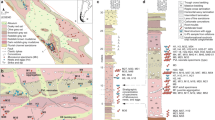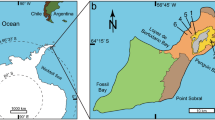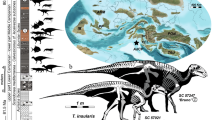Abstract
Mesozoic mammals are commonly portrayed as shrew- or rat-sized animals that were mainly insectivorous, probably nocturnal and lived in the shadow of dinosaurs1,2,3,4,5. The largest known Mesozoic mammal represented by substantially complete remains is Repenomamus robustus, a triconodont mammal from the Lower Cretaceous of Liaoning, China6,7. An adult individual of R. robustus was the size of a Virginia opossum. Here we report a new species of the genus, represented by a skeleton with most of the skull and postcranium preserved in articulation. The new species is 50% larger than R. robustus in skull length. In addition, stomach contents associated with a skeleton of R. robustus reveal remains of a juvenile Psittacosaurus, a ceratopsian dinosaur. Our discoveries constitute the first direct evidence that some triconodont mammals were carnivorous and fed on small vertebrates, including young dinosaurs, and also show that Mesozoic mammals had a much greater range of body sizes than previously known. We suggest that Mesozoic mammals occupied diverse niches and that some large mammals probably competed with dinosaurs for food and territory.
This is a preview of subscription content, access via your institution
Access options
Subscribe to this journal
Receive 51 print issues and online access
$199.00 per year
only $3.90 per issue
Buy this article
- Purchase on Springer Link
- Instant access to full article PDF
Prices may be subject to local taxes which are calculated during checkout




Similar content being viewed by others
References
Bakker, R. T. Dinosaur physiology and the origin of mammals. Evolution 25, 636–658 (1971)
Hopson, J. A. Endothermy, small size and the origin of mammalian reproduction. Am. Nat. 107, 446–452 (1973)
Jerison, H. J. Evolution of the Brain and Intelligence (Academic, New York, 1973)
Crompton, A. W., Taylor, C. R. & Jagger, J. A. Evolution of homeothermy in mammals. Nature 272, 333–336 (1978)
Lillegraven, J. A. in Mesozoic Mammals: The First Two-thirds of Mammalian History (eds Lillegraven, J. A., Kielan-Jaworowska, Z. & Clemens, W. A.) 1–6 (Univ. California Press, Berkeley, 1979)
Li, J.-L., Wang, Y., Wang, Y.-Q. & Li, C.-K. A new family of primitive mammal from the Mesozoic of western Liaoning, China [in Chinese]. Chin. Sci. Bull. 45, 2545–2549 (2000)
Wang, Y.-Q., Hu, Y.-M., Meng, J. & Li, C.-K. An ossified Meckel's cartilage in two Cretaceous mammals and origin of the mammalian middle ear. Science 294, 357–361 (2001)
Zhou, Z.-H., Barrett, P. M. & Hilton, J. An exceptionally preserved Lower Cretaceous ecosystem. Nature 421, 807–814 (2003)
Li, C.-K., Wang, Y.-Q., Hu, Y.-M. & Meng, J. A new species of Gobiconodon from the Jehol Biota and its implication to the age of the fauna. Chin. Sci. Bull. 48, 177–182 (2003)
Wang, S.-S., Wang, Y.-Q., Hu, H.-G. & Li, H.-M. The existing time of Sihetun vertebrate in western Liaoning, China—Evidence from U-Pb dating of zircon [in Chinese with English abstract]. Chin. Sci. Bull. 46, 779–782 (2001)
Xu, X. & Wang, X.-L. A new dromaeosaur (Dinosauria: Theropoda) from the Early Cretaceous Yixian Formation of western Liaoning. Vert. PalAsiat. 42, 111–119 (2004)
Nowak, R. M. Walker's Mammals of the World 6th edn (Johns Hopkins Univ. Press, Baltimore, 1999)
Silva, M. & Downing, J. A. CRC Handbook of Mammalian Body Mass (CRC Press, Boca Raton, 1995)
Jenkins, F. A. Jr Limb posture and locomotion in the Virginia opossum (Didelphis marsupialis) and in other non-cursorial mammals. J. Zool. 165, 303–315 (1971)
Fischer, M. S., Schilling, N., Schmidt, M., Dieter Haarhaus, D. & Witte, H. Basic limb kinematics of small therian mammals. J. Exp. Biol. 205, 1315–1338 (2002)
Wilson, R. W. Late Cretaceous (Fox Hills) multituberculates from the Red Owl Local Fauna of western South Dakota. Dakoterra 3, 118–132 (1987)
Clemens, W. A., Wilson, G. P. & Molnar, R. E. An enigmatic (synapsid?) tooth from the Early Cretaceous of New South Wales, Australia. J. Vert. Paleontol. 23, 232–237 (2003)
Jenkins, F. A. Jr & Schaff, C. R. The Early Cretaceous mammal Gobiconodon (Mammalia, Triconodonta) from the Cloverly Formation in Montana. J. Vert. Paleontol. 8, 1–24 (1988)
Rougier, G. W. Vincelestes neuquenianus Bonaparte (Mammalia, Theria), un Primitivo Mammifero del Cretaccico Inferior de la Cuenca Neuqina PhD Thesis, Univ. Nacional de Buenos Aires, Buenos Aires (1993)
Alexander, R. McN., Jayes, A. S., Maloiy, G. M. O. & Wathuta, E. M. Allometry of limb bones of mammals from shrews (Sorex) to elephant (Loxodonta). J. Zool. 189, 305–314 (1979)
Van Valkenburgh, B. in Body Size in Mammalian Paleobiology: Estimation and Biological Implication (eds Damuth, J. & MacFadden, B. J.) 181–205 (Cambridge Univ. Press, Cambridge, 1990)
Coombs, W. P. Jr Juvenile specimens of the ornithischian dinosaur Psittacosaurus . Palaeontology 25, 89–107 (1982)
Carbone, C., Mace, G. M., Roberts, S. C. & Macdonald, D. W. Energetic constraints on the diet of terrestrial carnivores. Nature 402, 286–288 (1999)
Van Valkenburgh, B. & Jenkins, I. Evolutionary patterns in the history of Permo-Triassic and Cenozoic synapsid predators. Paleontol. Soc. Pap. 8, 267–288 (2002)
Reilly, S. M., McBrayer, L. D. & White, T. D. Prey processing in amniotes: biomechanical and behavioral patterns of food reduction. Comp. Biochem. Physiol. A Mol. Integr. Physiol. 128, 397–415 (2001)
Van Valkenburgh, B., Sacco, T. & Wang, X.-M. Pack hunting in Miocene Borophagine dogs: Evidence from craniodental morphology and body size. Bull. Am. Mus. Nat. Hist. 279, 147–162 (2004)
Damuth, J. & MacFadden, B. J. in Body Size in Mammalian Paleobiology: Estimation and Biological Implication (eds Damuth, J. & MacFadden, B. J.) 1–10 (Cambridge Univ. Press, Cambridge, 1990)
Lillegraven, J. A., Kielan-Jaworowska, Z. & Clemens, W. A. (eds) Mesozoic Mammals: The First Two-thirds of Mammalian History (Univ. California Press, Berkeley, 1979)
Crompton, A. W. in Comparative Physiology: Primitive Mammals (eds Schmidt-Nielsen, K., Bolis, L. & Taylor, C. R.) 1–12 (Cambridge Univ. Press, Cambridge, 1980)
Eisenberg, J. F. in Body Size in Mammalian Paleobiology: Estimation and Biological Implication (eds Damuth, J. & MacFadden, B. J.) 25–38 (Cambridge Univ. Press, Cambridge, 1990)
Acknowledgements
We thank M.-M. Chang, Z.-H. Zhou, X.-L. Wang, X. Xu, F.-C. Zhang, Y. Wang, F. Jin and J.-Y. Zhang for help coordinating the research and fieldwork; X. Xu, X.-L. Wang, F.-C. Zhang, Z.-H. Zhou, and M. Norell for discussions on the research subject, and S.-H. Xie, S.-J. Li and A. Davidson for specimen preparation. This work was supported by funding from the Chinese Ministry of Science and Technology, the National Natural Science Foundation of China and the Chinese Academy of Sciences. Y.H. is also supported by a fellowship from the American Museum of Natural History, through the City University of New York.
Author information
Authors and Affiliations
Corresponding author
Ethics declarations
Competing interests
The authors declare that they have no competing financial interests.
Supplementary information
Supplementary Information Notes
This Supplementary Information text includes: (I) body mass estimation for two species of Repenomamus; (II) stomach content preparation and identification for R. robustus (IVPP V 13605); (III) Data sources for Figure 4 (sizes of the lower jaws of representative Mesozoic mammals and relatives). The file contains six figures. (DOC 1625 kb)
Rights and permissions
About this article
Cite this article
Hu, Y., Meng, J., Wang, Y. et al. Large Mesozoic mammals fed on young dinosaurs. Nature 433, 149–152 (2005). https://doi.org/10.1038/nature03102
Received:
Accepted:
Issue Date:
DOI: https://doi.org/10.1038/nature03102
This article is cited by
-
Derived faunivores are the forerunners of major synapsid radiations
Nature Ecology & Evolution (2023)
-
An extraordinary fossil captures the struggle for existence during the Mesozoic
Scientific Reports (2023)
-
On the way from Asia to America: eutriconodontan mammals from the Early Cretaceous of Yakutia, Russia
The Science of Nature (2023)
-
Unravelling the postural diversity of mammals: Contribution of humeral cross-sections to palaeobiological inferences
Journal of Mammalian Evolution (2023)
-
Petrosal morphology of the Early Cretaceous triconodontid Astroconodon from the Cloverly Formation (Montana, USA)
Journal of Mammalian Evolution (2023)
Comments
By submitting a comment you agree to abide by our Terms and Community Guidelines. If you find something abusive or that does not comply with our terms or guidelines please flag it as inappropriate.



